Your Planets
Portraits of the Planets
Aspects between Planets
The planetary ages
The planetary families
Planets in Signs
The Planets in comics



For more than 2500 years astrologers have had only one concept intuitive and empirical of what the objective reality of an Aspect is. They confined themselves to observing empirically certain real effects and imagining unreal ones. Very rare and very embryonic have been the attempts at conceptualization and therefore at theorization, such as that exposed by Ptolemy in the 2nd century and that proposed by Kepler in the 17th. Both resulted in erroneous explanations and failures. It is only in the 20th century that the concept of Aspect began to be truly elaborate, making it possible to distinguish the true from the false in the antique and traditional notions and formulate a rational explanatory theory through an overall conception of astrology. The contemporary design and graphical representation of the Aspects are the product of a long history, and the very idea of Aspect has evolved over the millennia.
The long history of the conception of the Aspects and their orbs shows that in order to measure them, the vast majority of learned astrologers, who were usually also astronomers, practically always neglected the ecliptic latitudes of the planets. The absence of this coordinate in the calculation of the Aspects is a phenomenon all the more interesting and meaningful that these observers and researchers of the sky could not ignore the existence of this phenomenon. And to understand why, we need to (re)take a brief space-time excursion to Mesopotamia at least three millennia ago.
The video below (4′ 27″) is a commented animation of the notion of Aspect among the Sumerians and Babylonians.
One can imagine that the first Middle Eastern astronomers-astrologers were extremely sensitive, when they observed the planets to try to predict their future movements, at times when two stars (two planets or a planet and a star) were located very close in both longitude and latitude. They were then considered to be in conjunction. It was indeed in these moments that the total or partial eclipses, major celestial events that imposed themselves on their perception by their rarity. And we have seen that at the beginning and due to its rare, spectacular and immediately perceptible character, the conjunction was the only Aspect, not only that interested them visually, but of which they could easily observe and predict the periodic reappearances.
They could thus have stuck to a conjunction design exclusively based on concealments planetary or stellar (therefore both on the latitudes and ecliptic longitudes) to record on their clay tablets its periodic appearances. If this had been so, the angles of the other Aspects which were gradually discovered would also have been calculated according to these two coordinates. And because of this, the conception of the Aspects as angles calculated exclusively in arcs of ecliptic longitude inside an orb, which gradually imposed itself over the centuries, would never have seen day or night. The ephemerides, inscriptions which list the positions of stars at regular intervals, would have had a shortened content, the exact or almost exact Aspects on the ecliptic do not occur all in all quite rarely. And these, inscribed in the center of our charts of the sky since the graphic revolution of Choisnard, would appear there only in extremely reduced numbers: only those would appear between planets without ecliptic latitude at the time of an event such as a birth. Suffice to say that a a very large number of Charts would simply not have Aspects.
But that’s not how things turned out. The periodicity of the high latitudes of the Moon, Mars and especially Venus, three planets whose apparent diameters made them the most visible and therefore the most easily accessible to observation, changed this situation. The pioneering Mesopotamian astronomers-astrologers thus realized that the periodicity of their exact conjunctions in longitude and latitude was in fact indexed to that, more general and more frequent, of their positions in longitude alone.
Admittedly, a conjunction in longitude and with a high simultaneous latitude of the two planets, especially if one is higher and the other lower, was less spectacular (the distance from Venus to Mars measured in height can then be more than 13° although they are on the same degree of longitude), but it was just as regularly periodic. They thus discovered that latitudinal exact conjunctions were only a special case of an intercycle whose frequency they could measure with longitudes alone. The latitudes were therefore gradually brought to be no longer considered as anything but epiphenomena, that is to say particular (and let us recall very spectacular) periodic appearances of the underlying temporal phenomenon measured by longitudes, visually much less impressive.
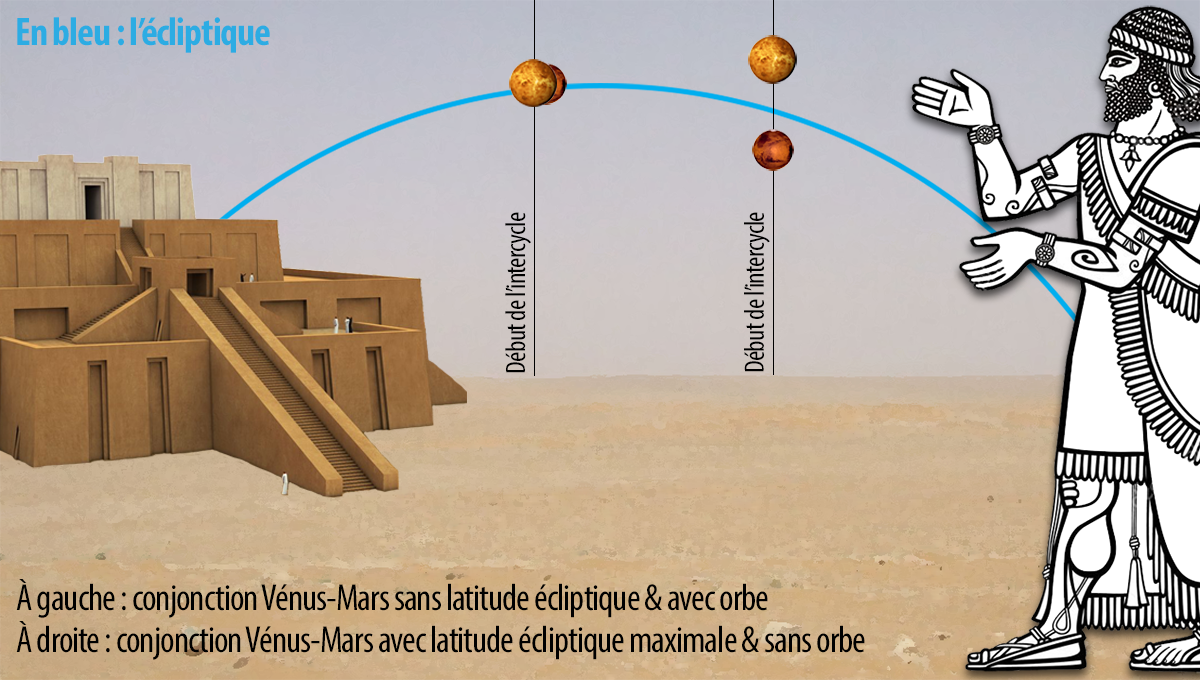
From this point of view, the exact conjunctions on the ecliptic were a strong signal which as such imposed itself first. It took a lot of time, patience and thought for the Mesopotamian astronomers-astrologers to realize that this strong visual signal was determined by a weak signal, certainly less appealing to the eye, but more fundamental. This deduction was also confirmed by the accumulation of observations concerning the effects of conjunctions, which appeared as similar with or without latitude. This was the foundation of what would become, centuries later, laboriously and through many errors and wanderings (as is the case for all knowledge and all sciences), a proto-theory of Aspects according to which these are measured in ecliptic longitudes.
It should be noted that it is not at all certain that the generations of astronomers-astrologers who followed one another kept in mind the circumstances of this discovery of the independent nature of planetary intercyclicities with respect to latitudes. It is even probable that they lost sight of it while traversing their temporal path, considering it as an acquired fact on which there was no longer any need to return or to wonder. At least that is what the remarkable constancy with which they have stuck, consciously or unconsciously and over the centuries, to the longitudinal coordinate to define and measure the Aspects in the sky and to report them in the ephemeris.
After all, over such a long period, at least some of them could have changed their minds on this subject, and decided to opt for longitudinal angular distances and latitudinal, imagine a method of arithmetic or arithmological calculation allowing to associate longitude and latitude in the consideration of the Aspects. Or, as an extreme solution, to opt for a kind of mean ecliptic plane whose degree of inclination on the real ecliptic would be the result of the average of the then observable latitudes taking into account the known planets. However, this never happened, or if it did, archeology (for Mesopotamian sources) or archives (for post-Ptolemaic astrology) have kept no trace of it.
This striking persistence in referring to longitudes to define the Aspects challenges and interrogates. It was the work of astrologers who were very frequently at the same time astronomers (there is no question here of ignorant and charlatan pseudo-astrologers). All those who were, therefore, knew what they were doing by dismissing the ecliptic latitudes. If they persisted in doing so, it is therefore because, in addition to the results of the observations that they owed to their practice, they had good reasons and/or intuitions that encouraged them to maintain this frame of reference.
But we can also think that they may have been misguided because of an initial presupposition which seemed astrometrically founded which was in fact a mistake. However, it is not. If the astrologers may not have all thought about the referential plan of the Aspects with knowledge of the facts, they have all done it with knowledge of the effects. It is obviously regrettable that no one has explained the good or bad reasons for this exclusion of ecliptic latitudes. Even Kepler, yet so eloquent in his writings to evoke the least of the astronomical or astrological problems which he was confronted with and on which he questioned himself, did not mention them when the Aspects were at the center of his conception of astrology. It now remains to clearly identify the cause of this objective choice.
The video below (7′ 06″) is a commented animation of the role of ecliptic latitudes in Aspects.
An Aspect being the phase of a cycle or an intercycle, the representation of this phase in a cycle graph in the form of an angle eliminates de facto any reference to his ecliptic latitude. From this point of view, it is not the angle determined by the three spatial dimensions between two planets that matters, but the one for example which characterizes the half-period (opposition) of this cycle.
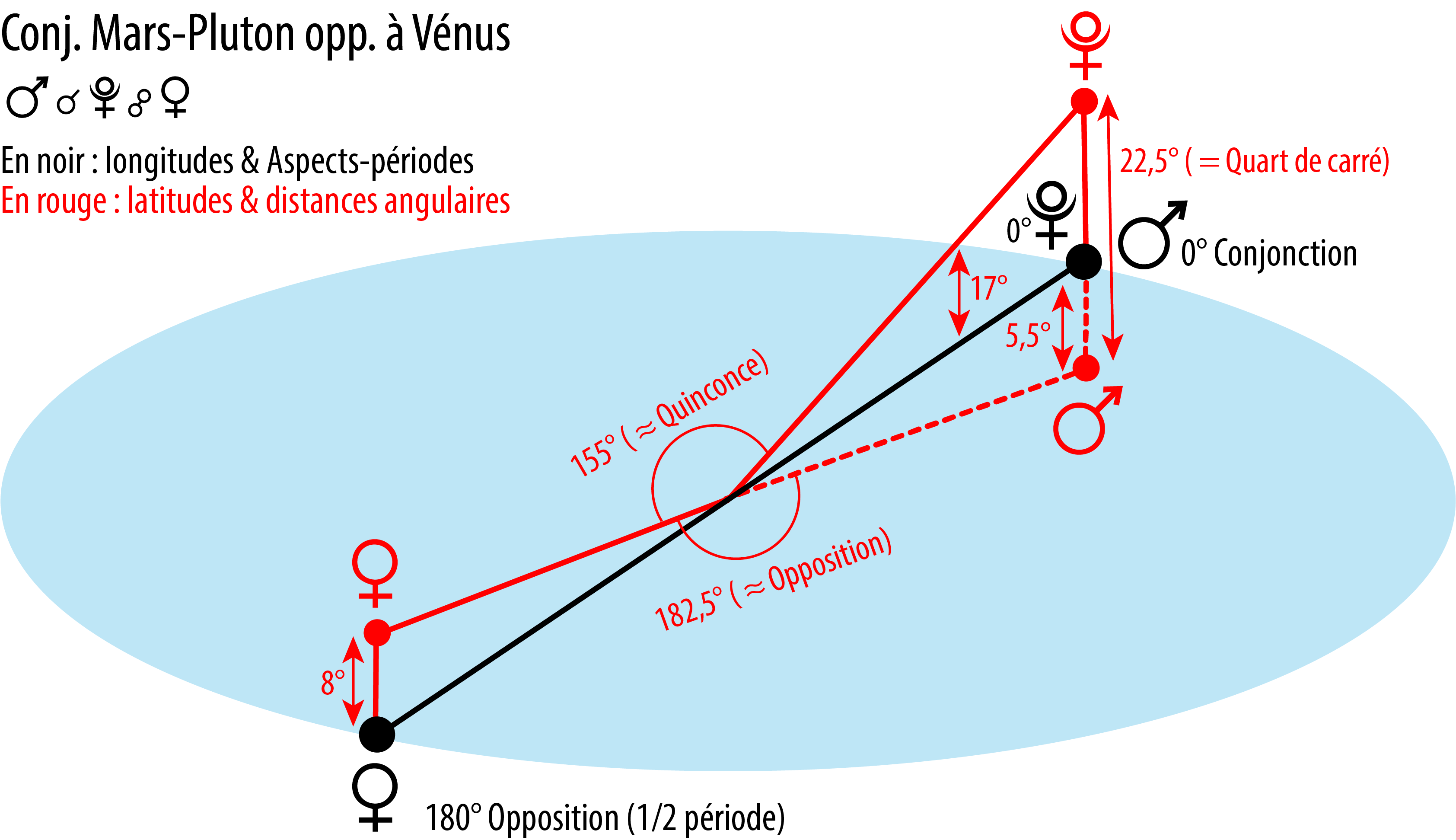
The figure above demonstrates this. It represents, in three dimensions, an opposition without an orb between Venus and Mars-Pluto. This simultaneous configuration of three Aspects indicates that Venus-Mars and Venus-Pluto intercycles are in their half-periods, which can be formally represented by an angular distance of 180° on the cycle graph (line segment black), while Mars-Pluto, spouses, are at 0° therefore at the beginning of their future new intercycle and at the end of the previous one. These three planets all approximate their extreme ecliptic latitudes, either North (+8° for Venus and +17° for Pluto), or South (−5.5° for Mars).
Therefore the geometric Venus-Pluto angle is not 180°, but 155°, which puts it out of the orb of the Aspect of opposition but rather brings it closer to quincunx (150°). The difference between the geometric angle of Venus-Mars (182.5°) and its cycle graph angle is less important (2.5°), which is explained by the fact that these two planets have opposite latitudes (North for Venus, South for Mars) and that of Mars is much smaller than that of Pluto. As for the Mars-Pluto conjunction located on either side of the ecliptic, it is characterized by a difference in height of 22.5°, whereas it is located at 0° in longitude, this vertical difference corresponding to the value of a very minor Horizontal Aspect of half square…
There is something to be perplexed about… But this perplexity disappears if one does not confuse the purely spatial angles (therefore timeless) and those that represent the phases of a time cycle in a graph. In this case, for example, the purely spatial angle of 155° between Venus and Pluto, induced by their latitudes, has absolutely no importance. What is measured by this Aspect is not this angle, it is the half period of their intercycle, which is represented graphically by an angle of 180°. And this is the reason why astrologers have always favored the ecliptic plane to determine and calculate the Aspects.
Of course, one can wonder about the real or supposed effects of latitudes. Those of a conjunction between two planets having strong North and South latitudes are they equivalents to those of another between the exact same planets on the ecliptic? Observation and practice tend to show that this is not the case. Otherwise, one would find in the archives many mentions of astronomers-astrologers who would have mentioned it, which does not mean that there are not a few left possible refinements to discover by continuing to research.
And on this side, it is necessary in priority to be wary of analogies based on pure appearances or similar figures between longitudes and latitudes. The vertical gap of 22.5° (equivalent to a semi-semi-square in longitude) between Mars and Pluto in our example does not mean that these two planets are in dissonant Aspect: an angular deviation in latitude is not the equivalent of an Aspect in longitude, even if the number of degrees is the same. Mars and Pluto are therefore not in semi-semi-square: they are in conjunction, even though Pluto is much higher than Mars in the sky.
To stay with the reflections that this graph may inspire, let us point out that the latitude argument is one of those who like to brandish the anti-astrologers believing themselves to be a little less ignorant than their colleagues to claim that astrologers tell nonsense by projecting the Aspects on a single plane, and that they are for example incapable of making the difference between 155° and 180°. We have just demonstrated that this argument is inadmissible. Of course, most contemporary astrologers, uninformed of the astrometric foundations of their practices and generally indifferent to them, would be unable to counter it, which does not change the fact that this apparently realistic but fundamentally fallacious argument does not hold water.
On this subject Henri Broch, a fanatical anti-astrologist, is particularly distinguished. In page 47 of the section of his book Au Cœur de l’extraordinaire devoted to astrology, he based himself, among other things, on this argument of latitudes to attack it. And he did it by committing two huge mistakes in his demonstration. This is particularly based on a Mercury-Pluto opposition, analogous to the Venus-Pluto opposition in the example above. He describes a Mercury at +7° and a Pluto at +17° in height North on the ecliptic, i.e. in what he considers to be their maximum heights with respect to this plane. The astrometric knowledge of this pseudo-zetetician giver of lessons indeed seem very incomplete, since the +7° of Mercury does not correspond at all to its latitude, but to the inclination of its orbit on the ecliptic (7° 18′ very exactly) rounded to the lower unit. The table below details all the orbital inclinations (which are heliocentric parameters) and the ecliptic latitudes (which are geocentric parameters) associated with them. Given the gross error that Broch makes for Mercury by confusing orbital inclination and latitude, it is likely that he committed the same concerning Pluto.
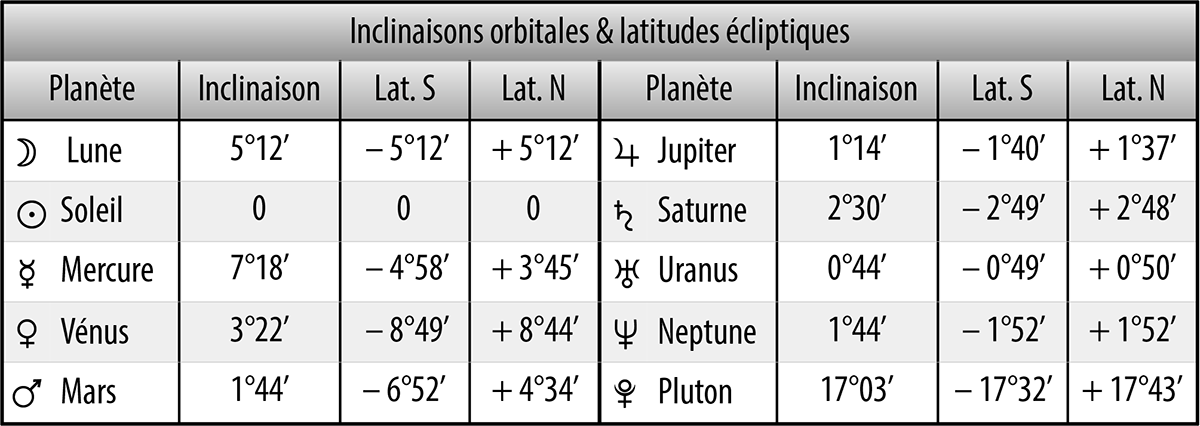
It is however obvious that orbital inclination and ecliptic latitude cannot be confused, the latitudes being a geocentric effect induced both by the planet-Earth distance and by the inclinations of the orbits. Indeed, as shown in the graph below, the ecliptic latitude of a planet — here Mercury — varies according to its distance from the Earth and the Sun. In the case of Mercury, it does not exceed +4° North and −5° South. Broch has it all wrong. When we claim to give astrology lessons, we must know what we are talking about. Or confine oneself to teaching pseudo-zetetic.
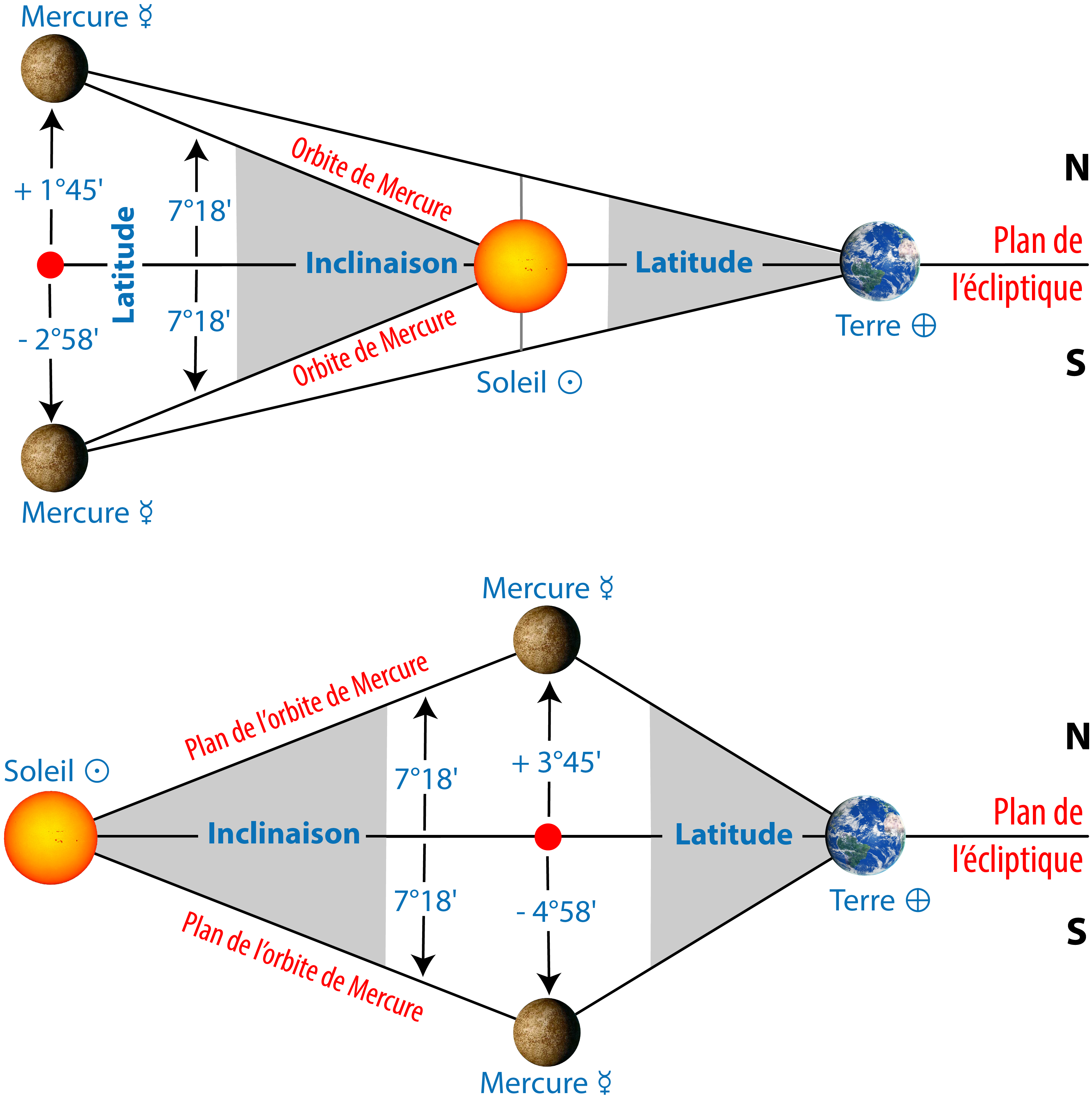
That’s not all: not satisfied with confuse orbital inclinations and ecliptic latitudes, Broch is also mistaken in writing that an angle of 23° of latitude between two planets in exact conjunction “would be more like a semi-quadrature than a conjunction”. This time not only grossly confuses latitude and longitude, but also proves unable to do a division properly. Indeed, if a quadrature (square) is 90°, a semi-quadrature is worth 45, not 22.5, which is the exact value of a quarter quadrature. Pin a again all wrong, which does not prevent him from concluding from his own errors that “the Aspects used by astrologers therefore translate, in some cases, in a totally erroneous way the real angles that the stars can form between them.” This is an example of what commonly happens to all those who claim to tackle a subject of which they do not master and do not understand the data while claiming to be specialists in it. The pontificating demonstrations of these balloons then deflate when they fall on bones, and here the bone is astrometric… In the case of the anti-astrologer Broch, it is particularly tasty if one is inclined towards irony and derision.
The importance of the ecliptic latitudes also appears in the astrologer Max Duval (1930–2000): “One can however think that a transit by conjunction in particular has any chance of being all the more efficient as the latitude of the transiting planet is all the more close to the natal position transited […] It is the only means of prognosis based on actual astronomical positions”, he writes in La Domification et les transits (Traditional editions, 1987). We see that since Ptolemy, it is always in the field of forecasting techniques that latitudes are most often invoked.
Max Duval was a learned astrologer and fond of astronomy, nevertheless he was probably wrong on this subject: observation and practice show that the effectiveness of a transit, whatever the Aspect, does not seem to be proportional to the similarity of the positions in ecliptic latitude of the planets concerned. This is an effect of the cyclical, temporal and non-spatial character of the Aspects: a conjunction does not require a partial or total occultation (spatial phenomenon) of the transiting or transited planet.
The astrologer Jean-Christophe Vitu makes the same error by estimating that “The current error of the Aspect calculation is to measure angles between points that exist only for the mathematician, namely the projections of these on the ecliptic.” It is only by projecting the Aspects onto one and the same spatial plane that they can be represented as the phases of a cycle or intercycle.
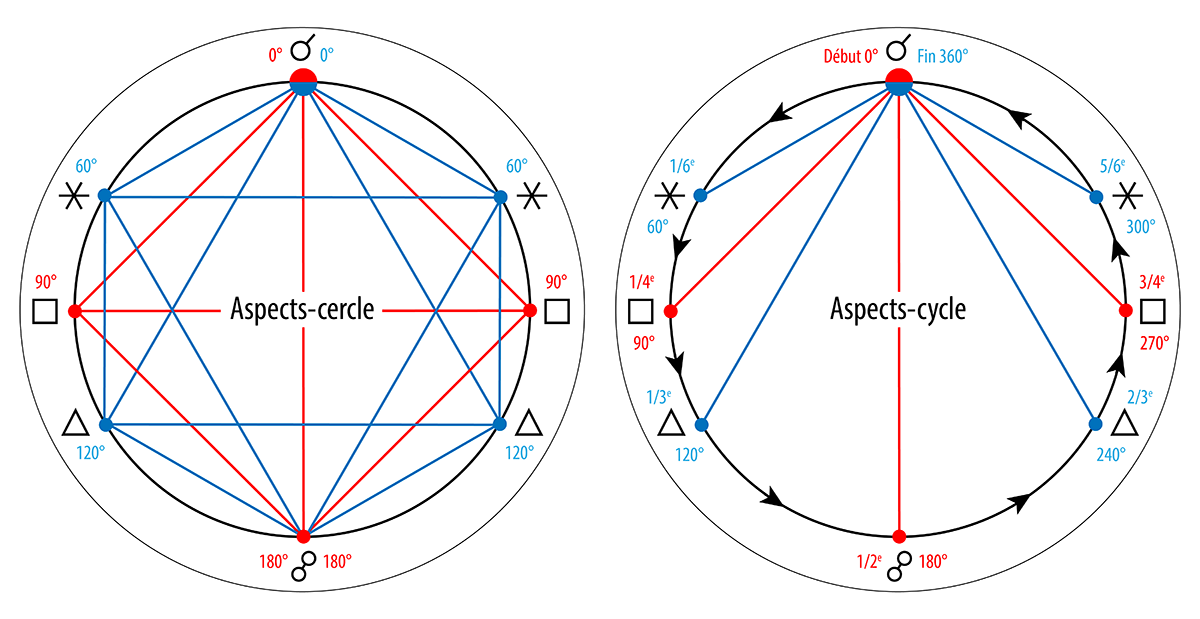
The diagrams above represent the two conceptions of the Aspects: on the left the Aspects-circle, and on the right the Aspects-cycle. We note that while having obvious similarities, they are nonetheless very significantly different:
▶ Circle Aspect Diagram: it is devoid of directional arrows, which expresses the droop of this conception of the Aspects. The latter, distributed horizontally on either side of the central axis of symmetry 0°–180° which connects the conjunction to the opposition, are the sides of regular polygons, and their different distances are measured with respect to their point of origin 0°: for example, the sextile is 60°, whether it is to the left or to the right of the conjunction. It is therefore a purely geometric space.
▶ Aspect cycle diagram: a directional arrow is inserted between each Aspect, which expresses the dynamism of this conception of the Aspects. These latter are the successive sequences of a temporal phenomenon which begins (0°) and ends (360°) conventionally at the moment of conjunction, the opposition being the half-period of this entire cycle. The Aspects are measured according to their progression with respect to the origin at 0°: for example, the sextile on the left is at 60° from this point, i.e. 1/6 of the cycle, while the one on the right is at 300°, i.e. 5/6. It is therefore a space-time, or more exactly a temporal phenomenon represented within a space.
Whether they are Aspects-circles or Aspects-cycles, Aspects do without latitudes. The former because these cannot be included in geometric space two-dimensional by which they are defined, the latter because they are the phases of a temporal scheme whose frequencies and periodicities are independent of latitudes.
The video below (8′ 05″) is a commented animation of the House Aspects & the Angle Aspects.
The House chart has been mentioned several times in this presentation. He doesn’t have one direct report with the Aspects, except through the real positions of the planets in the sectors of the local sphere (Houses). Misunderstood and misinterpreted, it can, like the pseudo-Aspects at the Angles, lead to confusion between the ecliptic coordinates of the celestial sphere (declinations, longitudes & latitudes) and the coordinates of the local sphere (horizon & meridian delimiting 4 quadrants whose tripartition produces the Houses). It is therefore necessary to specify what is the impact of domitudes on the Aspects.
The term “dominance” is a neologism coined by the astrologer Dom Néroman (1884–1953). It comes from the Latin “domus”, which means “house”. The domitude of a planet is therefore synonymous with its position in the House. This position seems obvious and yet it is not. The Tables of Houses, which make it possible to calculate it, are in fact based on the ecliptic longitudes of the Sun, which by definition has no ecliptic latitude, which is not the case for the Moon and the planets. The House Tables or the software that now replaces them therefore only give a very approximate position of the planets in Houses in placidian domification, especially in the case of Moon, Mercury, Venus, Mars and Pluto, which have the most important ecliptic latitudes.
Although hyper-traditionalist in his conception of astrology, Dom Néroman had in the 1st half of the 20th century the idea of trying to find a rational and astronomically based method of calculation to determine the real positions of the planets in Houses. He did this based on hour angle (portion of equator arc between the plane of the hour circle passing through the star and the plane of the celestial meridian). His excellent idea was taken up by astrologer Yves Lenoble in his article Le Thème de domitude (Cahiers Conditionalistes No. 4, ed. Comac, July 1981). He pointed out that “the tables of the Houses do not make it possible to precisely locate the position of a planet inside the House. And this can sometimes lead to errors in the election of the dominant.” The astrologer Jean-Christophe Vitu, in his article Du bon usage des latitudes, calculated the average of these errors over a period of two centuries. The table below lists them.
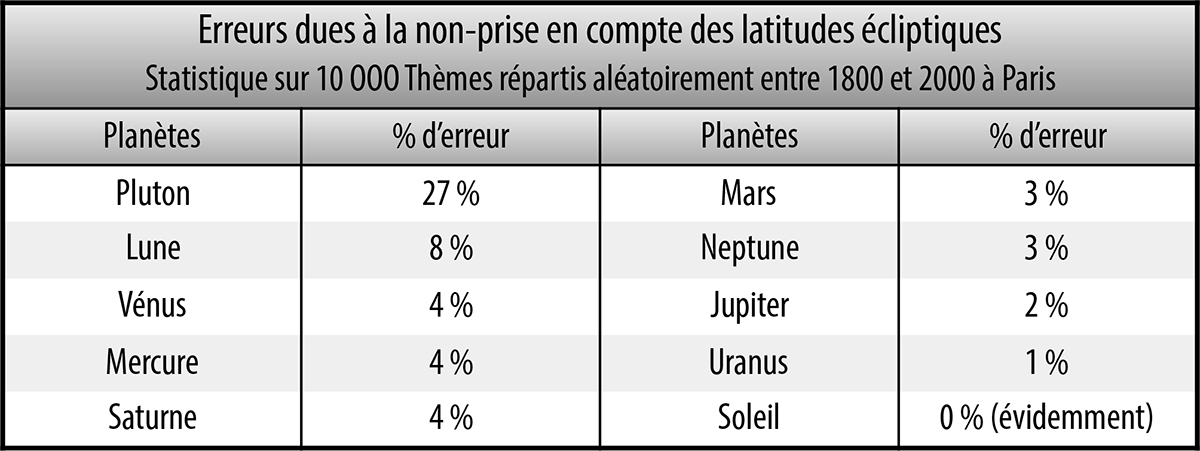
These are only statistical averages and, like all averages, they level off differences that can be considerable in the case of the Charts which combine strong ecliptic latitudes. The positions in Houses of the planets concerned are then completely false if one bases oneself only on their longitudes to calculate them. This does not affect Aspects and their orbs, as we have demonstrated, but it can change their order of importance. Indeed, it depends on the planetary hierarchy, which is directly affected by the positions in domitude.
This consideration of ecliptic latitudes therefore requires consulting the House chart. But the Aspects being calculated in ecliptic longitudes, their angular distances no longer relevant in this representation of the sky which privileges their real positions in Houses.
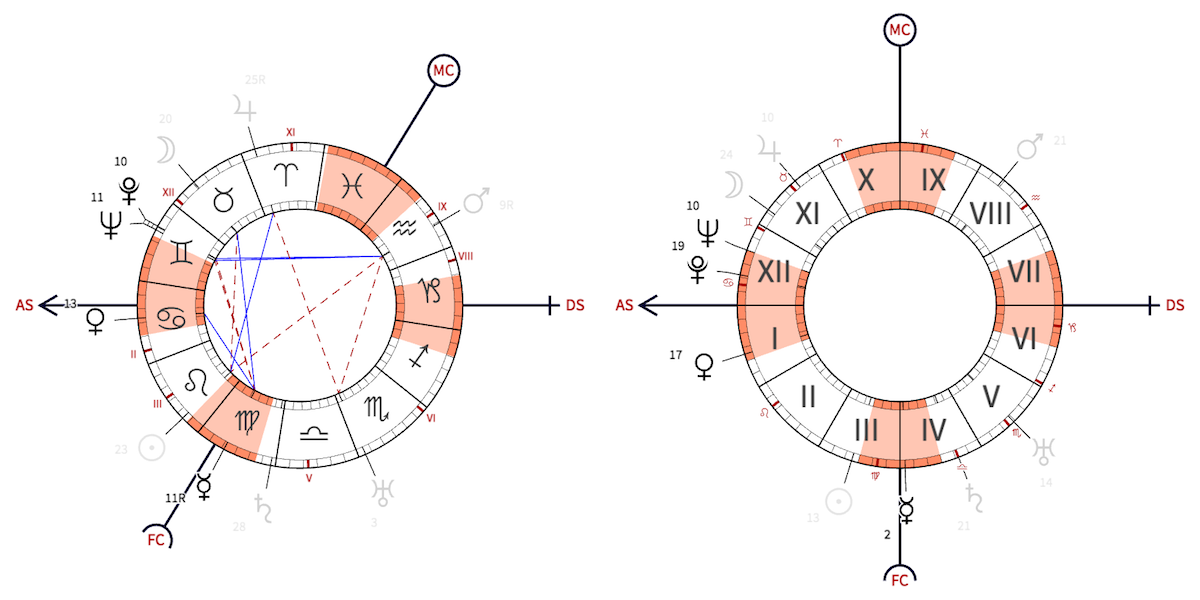
The Chart by physicist and mathematician Louis de Broglie (15/8/1892, 1 h, Dieppe) above offers an illustration of this. In these two sky maps, the orange areas represent the planetary angularity orbs calculated by our software Astrosoft.
▶ The sky map on the left is the Ecliptic chart, the calculation of which is based only on the ecliptic longitudes. We observe that only two planets seem angular and therefore dominant (in the orange zone therefore): Venus in Cancer, very close to the Ascendant (AS) in this same Sign and at the beginning of House I; And Mercury in Virgo at the Imum Coeli (IC) in House IV. These two planets being in addition in sextile, this Aspect can be considered as the most important. We also observe that the Neptune-Pluto conjunction at the beginning of House XII is not in a zone of valuation and seems very far from the Ascendant point. Finally, we observe that Pluto appears to be above Neptune. By relying on this representation, an uninformed astrologer will thus be tempted to underestimate the importance of this Aspect.
▶ The sky map on the right is the House chart, the calculation of which is based on both ecliptic longitudes and latitudes according to the houseification method of Ptolemy-Placidus. We observe that Venus is still in House I and in the valuation zone but close to the limit of it, and that it is in fact much lower below the horizon. Above all, we observe that the Neptune-Pluto conjunction is actually in the enhancement zone, due to the ecliptic latitudes of these two planets. That of Pluto (–11° 14′ S) being much higher than that of Neptune (–1° 33′ S), the real position of Pluto places it thus below Neptune, almost in the last third of House XII and therefore very close to the Ascendant. It follows that the dominant Aspect system is the Pluto-Neptune conjunction at the square of Mercury.
It is observed that if the Interplanetary Aspects figure in the Ecliptic chart, they are absent from the House chart. This absence is due to the fact that their angular distances, calculated in longitudes, cannot be represented identically in domitude: the planets form other angles in the local sphere, angles which are not Aspects but measurements made from their positioning in Houses.
To sum up: either we refer to the Chart of longitudes, and one can observe the ecliptic (the zodiac) with its Signs of 30° each, as well as the interplanetary Aspects. But we can’t know that Pluto, for example, is actually very close to the Ascendant. Either we refer to House chart, and taking into account the ecliptic latitudes makes it possible to observe the actual planetary positions in the local sphere and its 12 Houses. But in this chart of the sky the zodiac divided into 12 equal Signs of 30° disappears and you can no longer view the Interplanetary Aspects. A real black hole for astrologers!
This black hole or rather this white void in the middle of the House chart conceals a trap that must be avoided. It is displayed in animation in the video that accompanies this article. This trap lies in the temptation that some astrologers have had to fill this void with “Aspects of domitude”. In his article already quoted, Yves Lenoble reported on this temptation by writing that he “It would be interesting to check whether the Aspects common to the two Charts do not have a greater influence than the other Aspects.” So he seemed to be offering only a cautious research hypothesis… but his wording showed that he considered angular distances in domitude to be true Aspects.
Other astrologers (fortunately rare) after him were less cautious. The most moderate have made Lenoble’s hypothesis a certainty: for them, only the Aspects that count reproduce identically in ecliptic and domitude. It is a phenomenon that occurs quite rarely and under very specific astronomical conditions. This position has the consequence of drastically reducing the number of Aspects in at least two-thirds of the Charts, thus favoring a few rare intercycles to the detriment of all the others. As for the most fanatical (they are an ultra-minority), they no longer swear by the “Aspects of domitude”.
In both cases, these astrologers are deeply mistaken. They reproduce an error similar to that which led to the confusion between zodiacal angles and Planetary Aspects. The domitudinal angles are no more planetary Aspects than zodiacal angles. They are not the phases of an intercycle. Like the zodiacal angles, they are only straight lines in a geometric space, unrelated to the precise temporalities of the planetary Aspects.
Both Ecliptic charts below illustrate the position of the “moderate”. This is the same example as above. In the one on the left are represented the true Aspects, which are 12 in number. In the one on the right only appear the true Aspects identical to the domitudinal angles. They are only 6 to have survived, thanks to happy geometric coincidences, this arbitrary astro-psychedelic operation. This Chart has the advantage of radically simplifying interpretation.
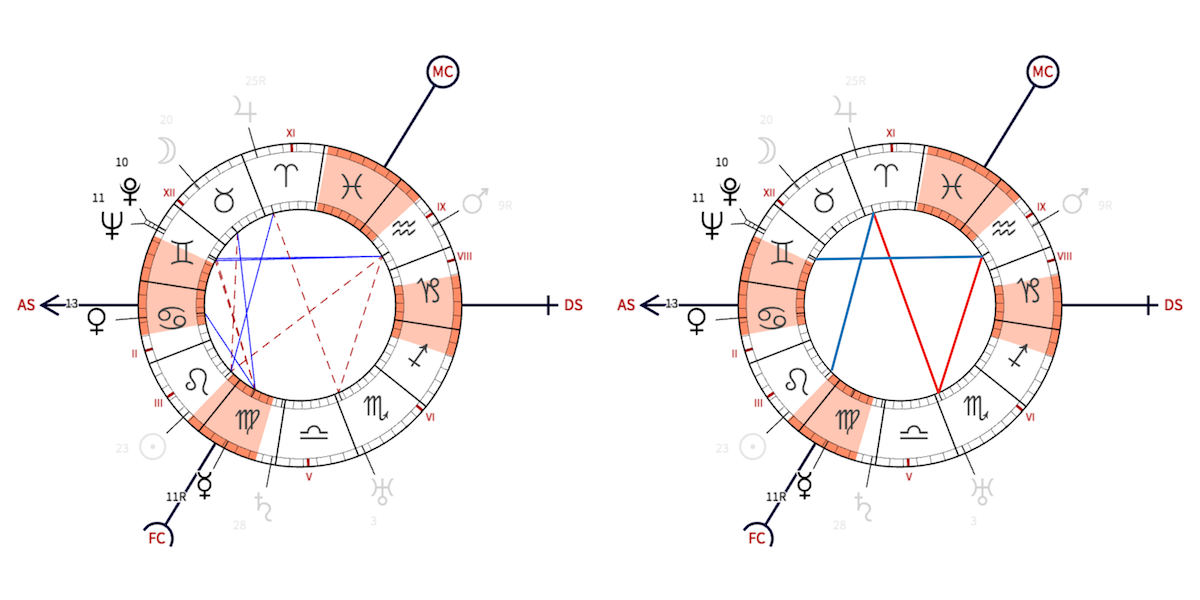
Both House charts below illustrate the position of the fanatics of pseudo-Aspects of domitude. In the one on the left there is no Aspect, as is normal in a House chart. In the one on the right are only the domitudinal angles including these weirdo are persuaded that they are the only true Aspects, in defiance of any astronomical reality.
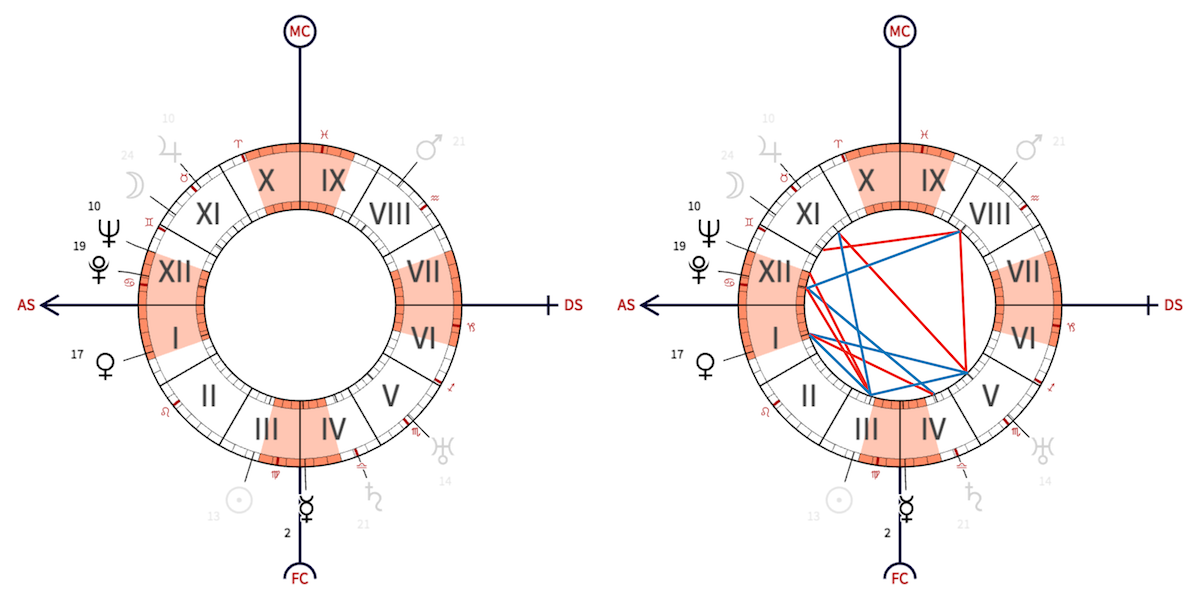
This lack of true Aspects in the House chart is inevitable, at least if we want to maintain realism of angular distances who represent them. However, we can decide to abandon all geometric realism and still feature the Aspects at the cost of serious spatial distortions. The two Charts below illustrate this possibility. To do this, it is imperative to abandon the representation of the Signs of Ecliptic chart of left, and to be satisfied to trace straight lines corresponding to the true Aspects in the House chart of right. In doing so and to give just two examples, the left 58° Venus-Mercury sextile transforms into an angle of 75°, and the left 90° Mercury-Pluto square into a 103° angle.
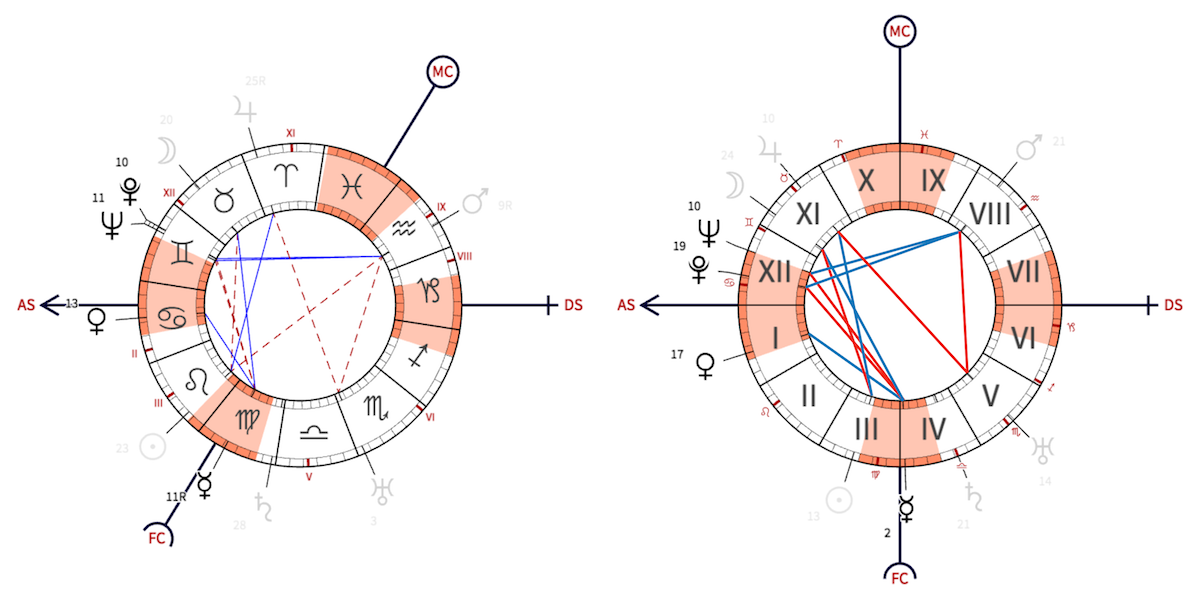
But it is much simpler, and more consistent with the reality of the angles of the Aspects, to be satisfied with two different and complementary sky maps: the ecliptic chart and that of domitude. The first provides information on the zodiacal planetary positions in ecliptic longitudes (but not in latitudes, and this makes the positions in Signs can be misleading) and the Aspects, the second on the real planetary positions in Houses, but without representation of the Signs of 30° of extent each and without Aspects. You have to be able to combine the two. Binocular vision gives a wider field of vision and a more precise appreciation of distances.
Finally, the House chart makes it possible to pose the problem of “Aspects to angles” in a more rational and astronomically more grounded way than the astrologers of the 17th century had done. Here is how Yves Lenoble describes this problem in his already quoted article:
“Often astrologers speak of Aspects in the Ascendant or Midheaven. We will say such a planet sextile to the Ascendant, trine to the Midheaven. Often these Aspects are not reproduced in the House chart. It can be said that, in this case, the astrologers mistakenly attribute to the diurnal movement characteristics of the cyclic movement. So it would be wiser to keep only the Aspects with the Angles which are in the two Charts. Moreover, these Aspects can be identified from the classic Chart.
With regard to the Ascendant, sextiles should only be retained if they fall at the tip of the XI or III, the trines at the tip of the IX or the V, the squares at the tip of the IV or X. With regard to the MC, the sextile must fall at the tip of XII or VIII, the square at the tip of I or VII and the trine at the tip of II or of the IV.”
It is true that by proceeding in this way, there is no longer any confusion between the diurnal movements of the local sphere and the cyclic movements of the celestial sphere… on condition of not calling “Aspects” these angles of domitude which are not. Yet Lenoble maintains this confusion here again. It is therefore best, as we have already observed, to eliminate the pseudo-Aspects at the Angles from all astrological theory and practice.
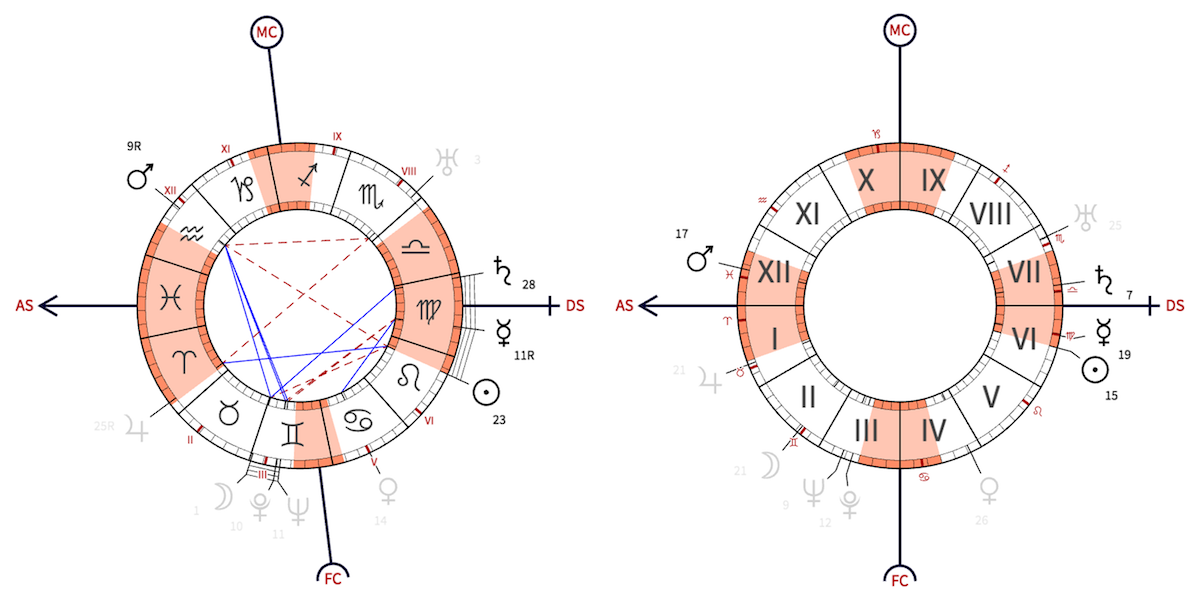
The above ecliptic and house charts are another excellent example of the indispensability of the house chart. They are built for the same day and the same place as that of Louis de Broglie, but at a different time: 20 h instead of 1 h. In the Ecliptic chart on the left, we observe that only two planets are angular: Mercury and Saturn in Virgo around the Descendant. There Mercury-Saturn conjunction at 17° 48′ of orb is therefore Aspect No. 1. It is also observed that Mars in Aquarius at the very beginning of House XII seems very distant from the Ascendant and therefore apparently not in the zone of orange angularity around it. It therefore seems undervalued.
This longitudinal marsian position is corrected in the House chart right: due to its ecliptic latitude of –6° 42′ S, Mars is actually very close to AS and becomes angular planet No. 1, passing in front of Mercury and Saturn. Thereby Mars-Sun opposition at 14° 03′ of orb becomes the Aspect No. 1 of this Chart and the Mercury-Saturn conjunction (whose angularity is confirmed by the domitudes of these planets) only comes afterwards… which clearly changes his interpretation.
It should also be noted in passing that due to its very high ecliptic latitude of –6° 42′ S, Mars in Aquarius in longitude actually has a Capricorn declination. It is therefore a Mars in Capricorn that must be taken into account… which also clearly changes its interpretation.
It is close to the horizontal plane (AS-DS axis) that the ecliptic latitudes of the planets are the most determining in their own valuation and that of their Aspects. It is necessary to know it… and for that to systematically consult the House chart.
Conclusion of this section: the calculation of planetary domitudes is one of the major innovations of the 20th century. As we have seen, it only has an indirect impact on the Aspects, only allowing a better assessment of their relative order of importance or hierarchical ranking: this indirect impact is therefore not without important consequences for the interpretation.
▶ Aspects theory and practice
▶ Les aspects, phases d’un cycle
▶ Aspects : existe-t-il un modèle traditionnel ?
▶ Aspects : théorie et bilan conditionaliste
▶ Introduction à l’interprétation des aspects
▶ The planetary Aspects and their orbs
▶ Les Aspects kepleriens
▶ Les “aspects” aux Angles
▶ Chronologie des Aspects et Transits
▶ Les Aspects planétaires
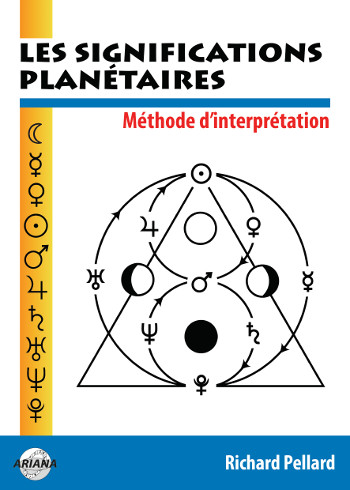
Les significations planétaires
par
620 pages. Illustrations en couleur.
La décision de ne traiter dans ce livre que des significations planétaires ne repose pas sur une sous-estimation du rôle des Signes du zodiaque et des Maisons. Le traditionnel trio Planètes-Zodiaque-Maisons est en effet l’expression d’une structure qui classe ces trois plans selon leur ordre de préséance et dans ce triptyque hiérarchisé, les Planètes occupent le premier rang.
La première partie de ce livre rassemble donc, sous une forme abondamment illustrée de schémas pédagogiques et tableaux explicatifs, une édition originale revue, augmentée et actualisée des textes consacrés aux significations planétaires telles qu’elles ont été définies par l’astrologie conditionaliste et une présentation détaillée des méthodes de hiérarchisation planétaire et d’interprétation accompagnées de nombreux exemples concrets illustrés par des Thèmes de célébrités.
La deuxième partie est consacrée, d’une part à une présentation critique des fondements traditionnels des significations planétaires, d’autre part à une présentation des rapports entre signaux et symboles, astrologie et psychologie. Enfin, la troisième partie présente brièvement les racines astrométriques des significations planétaires… et propose une voie de sortie de l’astrologie pour accéder à une plus vaste dimension noologique et spirituelle qui la prolonge et la contient.
Téléchargez-le dès maintenant dans notre boutique
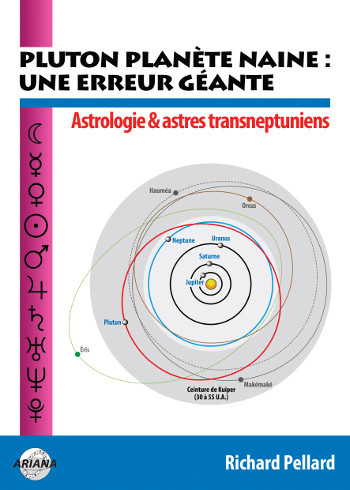
Pluton planète naine : une erreur géante
par
117 pages. Illustrations en couleur.
Pluton ne fait plus partie des planètes majeures de notre système solaire : telle est la décision prise par une infime minorité d’astronomes lors de l’Assemblée Générale de l’Union Astronomique Internationale qui s’est tenue à Prague en août 2006. Elle est reléguée au rang de “planète naine”, au même titre que les nombreux astres découverts au-delà de son orbite.
Ce livre récapitule et analyse en détail le pourquoi et le comment de cette incroyable et irrationnelle décision contestée par de très nombreux astronomes de premier plan. Quelles sont les effets de cette “nanification” de Pluton sur son statut astrologique ? Faut-il remettre en question son influence et ses significations astro-psychologiques qui semblaient avérées depuis sa découverte en 1930 ? Les “plutoniens” ont-ils cessé d’exister depuis cette décision charlatanesque ? Ce livre pose également le problème des astres transplutoniens nouvellement découverts. Quel statut astrologique et quelles influences et significations précises leur accorder ?
Enfin, cet ouvrage propose une vision unitaire du système solaire qui démontre, chiffes et arguments rationnels à l’appui, que Pluton en est toujours un élément essentiel, ce qui est loin d’être le cas pour les autres astres au-delà de son orbite. Après avoir lu ce livre, vous saurez quoi répondre à ceux qui pensent avoir trouvé, avec l’exclusion de Pluton du cortège planétaire traditionnel, un nouvel argument contre l’astrologie !
Téléchargez-le dès maintenant dans notre boutique